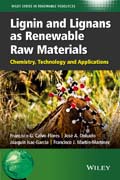
Lignin and Lignans as Renewable Raw Materials: Chemistry, Technology and Applications
Calvo–Flores, Francisco G.
Dobado, José A.
Isac–García, Joaquín
Martin–Martinez, Francisco J.
As naturally occurring and abundant sources of non–fossil carbon, lignin and lignans offer exciting possibilities as a source of commercially valuable products, moving away from petrochemical–based feedstocks in favour of renewable raw materials. Lignin can be used directly in fields such as agriculture, livestock, soil rehabilitation, bioremediation and the polymer industry, or it can be chemically modified for the fabrication of specialty and high–value chemicals such as resins, adhesives, fuels and greases. Lignin and Lignans as Renewable Raw Materials presents a multidisciplinary overview of the state–of–the–art and future prospects of lignin and lignans. The book discusses the origin, structure, function and applications of both types of compounds, describing the main resources and values of these products as carbon raw materials. Topics covered include: Structure and physicochemical properties Lignin detection methods Biosynthesis of lignin Isolation methods Characterization and modification of lignins Applications of modified and unmodified lignins Lignans: structure, chemical and biological properties Future perspectives This book is a comprehensive resource for researchers, scientists and engineers in academia and industry working on new possibilities for the application of renewable raw materials. For more information on the Wiley Series in Renewable Resources, visit www.wiley.com/go/rrs INDICE: Series PrefacePreface xiiiAcronyms xviiList of Symbols xxiPart One Introduction 11 Background and overview 31.1 Introduction 31.2 Lignin: economical aspects and sustainability 41.3 Structure of the book 5References 8Part Two What is lignin? 92 Structure and physicochemical properties 112.1 Introduction 112.2 Monolignols, the basis of a complex architecture 122.3 Chemical classification of lignins 152.4 Lignin linkages 192.5 Structural models of native lignin 222.6 Lignin–carbohydrate complex 372.7 Physical and chemical properties of lignins 44References 483 Detection and determination 533.1 Introduction 533.2 The detection of lignin (colour–forming reactions) 533.3 Determination of lignin 593.4 Direct methods for the determination of lignin 613.5 Indirect methods for the determination of lignin 653.6 Comparison of the different determination methods 72References 754 Biosynthesis of lignin 814.1 Introduction 814.2 The biological function of lignins 824.3 The shikimic acid pathway 824.4 The phenylpropanoid pathway 854.5 The biosynthesis of lignin precursors (the monolignol specific pathway) 864.6 The dehydrogenation of the precursors 924.7 Peroxidases and laccases 924.8 The radical polymerisation 954.9 The lignin–cabohydrate connectivity 1094.10 Location of lignins (cell walls lignification) 1114.11 Lignins from hybrids 1124.12 Differences between Angiosperm and Gymnosperm lignins 115References 119Part Three Sources and Characterization of Lignin 1275 Isolation of lignins 1295.1 Introduction 1295.2 Methods for lignin isolation from wood and grass for laboratory purposes 1305.3 Commercial lignins 143References 1546 Functional and spectroscopic characterization of lignins 1616.1 Introduction 1616.2 Elemental analysis and empirical formula 1616.3 Determination of molecular weight 1636.4 Functional group analyses 1676.5 Frequencies of functional groups and linkage types in lignins 1766.6 Characterization by spectroscopic methods 1826.7 Raman spectroscopy 186References 1957 Chemical characterization and modification of lignins 2077.1 Introduction 2077.2 Characterization by chemical degradation methods 2077.3 Other chemical transformations of lignins 2387.4 Other chemical modifications of lignins 2477.5 Thermolysis (pyrolysis) 2497.6 Biochemical transformations of lignins 250References 252Part Four Lignins Applications 2678 Applications of modified and unmodified lignins 2698.1 Introduction 2698.2 Lignin as fuel 2728.3 Lignin as a binder 2738.4 Lignin as chelant agent 2758.5 Lignin in biosciences and medicine 2768.6 Lignin in agriculture 2788.7 Polymers with unmodified lignin 2798.8 Other applications of unmodified lignins 2888.9 New polymeric materials derived from modified lignins and related biomass derivatives 2948.10 Polymers derived from chemicals obtainable from lignin decomposition 3048.11 Other applications of modified lignins 305References 3089 High–value chemical products 3139.1 Introduction 3139.2 Gasification: syngas from lignin 3159.3 Thermolysis of lignin 3169.4 Hydrodeoxygenation (hydrogenolysis) 3179.5 Hydrothermal hydrolysis 3199.6 Chemical depolymerisation 3219.7 Oxidative transformation of lignin 3249.8 High–value chemicals from lignin 328References 335Part Five Lignans 33910 Structure and chemical properties of lignans 34110.1 Introduction 34110.2 Structure and classification of lignans 34110.3 Nomenclature of lignans 34610.4 Lignan occurrence in plants 34910.5 Methods of isolation of lignans from plants 35410.6 Structure determination of lignans 35610.7 The chemical synthesis of lignans 357References 38711 Biological properties of lignans 40111.1 Introduction 40111.2 Biosynthesis of lignans 40211.3 Metabolism of lignans 41311.4 Plant physiology and plant defence 41811.5 Podophyllotoxin 42211.6 Biological activity of different lignan structures 435References 466Part Six Outcome and Challenges 49112 Summary, conclusions, and perspectives on lignin chemistry 49312.1 Sources of lignin 49312.2 On the structure of lignin 49412.3 Biosynthesis and biological function 49512.4 Applications of lignin 49512.5 Lignans 49712.6 Perspectives 498References 499General index 500Author index 501 .
- ISBN: 978-1-118-59786-6
- Editorial: Wiley–Blackwell
- Encuadernacion: Cartoné
- Páginas: 520
- Fecha Publicación: 11/09/2015
- Nº Volúmenes: 1
- Idioma: Inglés
